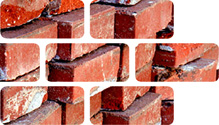
Bricks Inert 17 01 02
Bricks are mostly made from clay formed by extrusion or moulding, dried and fired in a kiln. Some bricks are made from concrete or calcium silicate. They are made in various colours, styles, shapes and sizes, depending on the specification required or materials available. They are of varying quality, strength and finish depending on their expected function and architectural finish. They are suitable for structural and non-structural uses.
Usage & Probable Locations
Bricks have many uses in construction, as they can be used to form almost any shape. They are used mostly to build walls, columns, foundations, architectural floors and arches. They are located in structural walls, cladding of houses, bridges, step foundations, perimeter walls, architectural structures, drainage shafts and garden decor.
Personal Protective Equipment
PPE requirements indicated are for guidance purposes only. DRIDS has identified the PPE that is mandatory on all demolition projects and ones that may be required subject to site specific Risk Assessment & Method Statement (RAMS). Hover over the icon to determine the types of PPE required for the removal of this material.
Removal, Segregation & Storage
Bricks that are destined for reuse should be deconstructed, cleaned of mortar, segregated and stored carefully and safely, to ensure their integrity and good condition. They should be stacked on timber pallets and bound with cling-film to prevent tumbling and away from plant movements to prevent splash damage. Crushed bricks that are destined for recycling should have the majority of contaminants removed to suit the quality protocol for recycled aggregates. Brick buildings, structures and infrastructure can be demolished using suitable plant and attachments and stored in piles of crushed materials that have been screened to remove metals and fines. There is no need to store palleted bricks or crushed bricks inside a building or under cover as they are robust against weather.
Fixtures, Fittings & Connections
Bricks have been traditionally bound together with mortars to other bricks, blocks, concrete, steel or timber products. Some brick products require no fixings, they are laid into place using mortar, screed or other binding agent. Bricks will sometimes be painted for decorative or protective purposes, such as white lime. Wall ties are used to create a cavity between two or more walls to provide integrity and breathability of the building. Wall ties are also used to connect timber wall plates and gable rafters. Joist hangers are occasionally fixed to brick walls to connect floor joists.
Health & Safety
Subject to task-specific Risk Assessment & Method Statement (RAMS). Wear gloves and respiratory protective equipment (where necessary) when handling concrete products, crushed materials, fire retardant materials or paints to prevent irritation, cuts and abrasion. Use eye protection when using hand tools. Limit hand, arm and whole body vibration when using air tools. Use harness protection at height. Only use 360 plant and attachments if appropriately trained.










